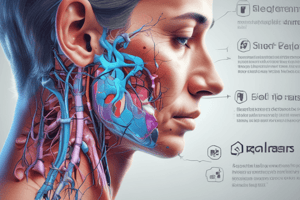Podcast
Questions and Answers
What is the purpose of a focused history in a patient's diagnosis?
What is the purpose of a focused history in a patient's diagnosis?
- To ask questions that will help rule in or rule out potential diagnoses (correct)
- To ask unnecessary questions about the patient's family history
- To only ask questions about the patient's medications
- To ignore the patient's significant medical problems
What is an important aspect of taking a patient's family history?
What is an important aspect of taking a patient's family history?
- Determining if certain conditions run in the patient's family (correct)
- Ignoring the patient's family medical history
- Inquiring about the patient's cousins' medical history
- Asking only about the patient's siblings
What should a physician do when conducting a review of systems?
What should a physician do when conducting a review of systems?
- Only perform a full physical exam
- Ask questions that help rule in or rule out potential diagnoses (correct)
- Only ask about the patient's musculoskeletal system
- Ignore the patient's reported symptoms
What is the purpose of asking about the patient's social history?
What is the purpose of asking about the patient's social history?
What is the main focus of a focused history?
What is the main focus of a focused history?
What percentage of diagnoses can be reached by combining history and physical examination?
What percentage of diagnoses can be reached by combining history and physical examination?
What is the recommended action if the patient's depression worsens?
What is the recommended action if the patient's depression worsens?
What happens to clinical reasoning as you gain experience?
What happens to clinical reasoning as you gain experience?
What should you do if you're confident about the diagnosis?
What should you do if you're confident about the diagnosis?
What should you discuss with the patient in terms of the plan?
What should you discuss with the patient in terms of the plan?
What should you do before saying goodbye to the patient?
What should you do before saying goodbye to the patient?
Why is it essential to discuss diagnostic possibilities with the patient?
Why is it essential to discuss diagnostic possibilities with the patient?
What is the purpose of asking if the patient has questions?
What is the purpose of asking if the patient has questions?
Study Notes
Focused History
- Review HPI and Approach to… lectures
- Ask questions that help you “rule in” or “rule out” diagnoses
- Ask about associated factors, such as hospitalizations/ER visits, medications, allergies, and surgeries
- Review Past Medical History (“SMASH”) and Social History
- Focus on key aspects of the patient's history, such as significant medical problems, family history, and lifestyle habits
Focused Physical Exam
- Not a full MSK exam, but a focused exam on the specific joint or area of concern
- Inspect, palpate, motion test, and strength test, and then do “special tests”
- Compare to the unaffected joint or area
- Don't forget to incorporate osteopathic assessment into your physical exam
Assessment
- What you think or know is wrong with the patient
- Can be a working diagnosis, problem list, reason for visit, or differential diagnosis
- 90% of the time, diagnosis can be reached by history plus physical
- Be specific if you're sure, and less specific if you're less sure
Diagnostic and Treatment Plan
- Confirm the diagnosis or rule out a “can’t miss” diagnosis
- Identify what information you need to know that you don't already have
- Develop a plan to address the patient's concerns and needs
- Discuss diagnostic possibilities with the patient and explain in layman's terms
Clinical Reasoning
- Three types of reasoning: pattern recognition, development of schemas, and application of relevant basic and clinical science
- As you gain experience, clinical reasoning begins at the outset of the patient encounter, not at the end
Studying That Suits You
Use AI to generate personalized quizzes and flashcards to suit your learning preferences.
Related Documents
Description
A comprehensive quiz on taking a focused history and physical examination, covering aspects such as acute or gradual onset, worsening symptoms, and associated conditions. Review HPI and approach to lectures.




